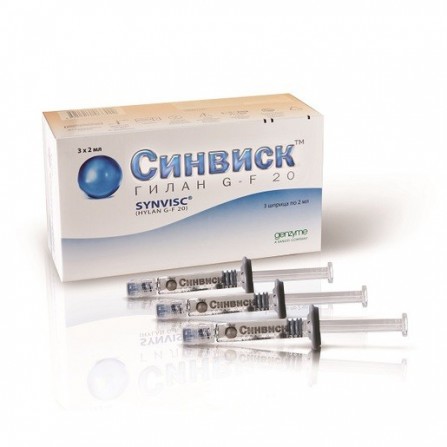Prosthesis synov.zhidky synvisc 2 ml N3
Condition: New product
1000 Items
Rating:
Be the first to write a review!

More info
Description
Synvisc or prosthesis of synovial fluid - a drug that allows you to fill the lack of natural lubrication for the joint and restore its rheological properties.
Active ingredients
Gilan
Composition
1 ml of the product contains: the active substance Hylan G-F 20 - 8 mg, sodium chloride - 8.5 mg, sodium hydrogen phosphate - 0.16 mg, sodium dihydrogen phosphate - 0.04 mg, water for injection - up to 1 ml.
Pharmacological effect
Synvisc / Synvisc is a sterile, pyrogen-free, viscoelastic fluid containing Hylans. Hylans are derivatives of hyaluronan (sodium salt of hyaluronic acid) and consist of repeating disaccharide units of N-acetylglycosamine and sodium glucuronate. The average molecular weight of guilan A is about b million. Dalton, guilan B is a hydrated gel. Synvisc / Synvisc contains Gilan A and Gilan B (8.0 mg ± 2.0 mg in 1 ml) diluted in physiological saline (pH 7.2 ± 0.3). Characteristics Synvisc / Synvisc is the biological analogue of hyaluronan. Hyaluronan is a component of the synovial fluid, causing its viscoelastic properties. However, the mechanical (viscoelastic) properties of Synvisc / Synvisc are higher than those of synovial fluid and hyaluronan solution in comparable concentrations. Synvisc / Synvisc has elasticity (storage modulus G ') at 2.5 Hz at 111 + 13 Pascal (Pa) and viscosity (loss modulus G ") at 25 ± 2 Pa. Elasticity and viscosity of synovial fluid of the knee joint aged 18-27 years, measured by the same method and at the same frequency, are respectively: G '= 117 + 13 Pa and G "= 45 + 8 Pa. Gylans are eliminated from the body in the same way as hyaluronan, and its decay products are not toxic.
Indications
Temporarily replaces and replenishes synovial fluid. Effective in patients at any stage of the joint pathology. Most effective in patients with active and regular load on the affected joint. It achieves its therapeutic effect by “restoring viscosity”, due to which rheological properties of synovial fluid and physiological properties of tissues of the joint affected by osteoarthrosis are restored. Restoration of viscosity is a treatment aimed at reducing pain and discomfort, as well as providing more extensive movement of the joints.In vitro studies have shown that Synvisc / Synvisc protects cartilage cells from certain physical and chemical damage. Synvisc / Synvisc is intended only for intra-articular injection by a doctor for the treatment of pain caused by osteoarthritis of the knee, hip, ankle or shoulder joint.
Contraindications
Venous or lymphatic stasis on the side of the affected joint. An infected or severely inflamed joint, signs of a skin infection in the immediate vicinity of the injection site. Hypersensitivity (allergy) to hyaluronan preparations (sodium hyaluronan).
Use during pregnancy and lactation
Contraindicated
Dosage and administration
The knee requires 3 injections with an interval of 1 week between them. The maximum dosage will be 6 injections for 6 months. For hip, shoulder and ankle osteoarthritis, 1 injection is recommended. For greater effect, you can repeat it in 1-3 months. Synvisc has no effect on the body as a whole.
Side effects
Short-term pain and / or swelling in the injection area and / or the appearance of intra-articular exudation. The post-marketing experience of using Synvisc / Synvisc has shown that in some cases exudation can be significant and cause more prolonged pain. In these cases, it is necessary to make a puncture of the joint and removal of exudate with its subsequent analysis to exclude infection and microcrystalline arthropathy. Usually such reactions disappear without a trace within a few days. The presence of such reactions does not affect the effectiveness of treatment. In the clinical studies of Synvisc / Synvisc, intra-articular infections have rarely been observed. Post-marketing experience revealed the presence of the following systemic reactions, which sometimes appear with the introduction of Synvisc / Synvisc - rash, urticaria, itching, nausea, headache, dizziness, chills, muscle cramps, Paresthesia, peripheral edema (including on the face), weakness, difficulty breathing, redness of the skin.
Interaction with other drugs
Do not use in conjunction with disinfectants to prepare the skin, containing quaternary ammonium salts, since in their presence hyaluronan may precipitate.
special instructions
1. Before each injection of Synvisc / Synvisc, synovial fluid or intraarticular exudate should be removed. 2. You can not use Synvisc / Synvisc in case the package is opened or damaged. 3. Synvisc / Synvisc should be administered at room temperature. 4.To remove the syringe from the blister (or case), it should be taken by the body, without touching the piston rod. 5. Synvisk / Synvisc should be entered in strict accordance with the rules of asepsis, therefore, it is necessary to observe appropriate precautions when removing the protective cap from the syringe. 6. It is necessary to turn the cap before removing it to minimize leaks of the drug. 7. Use an appropriate size (18-22) and needle length, depending on the joint into which the injection is intended. 8. To prevent leakage of the drug during insertion, keep the needle in close contact with the syringe. 9. Do not overtighten or apply excessive force when fixing the needle or removing the cap, as this may cause the tip of the syringe to break. 10. Do not re-sterilize Synvisc / Synvisc. 11. Enter Synvisc / Synvisc strictly into the articular space. If necessary, use a fluoroscopic determination of the direction of the injection, especially when injected into the hip and shoulder joint. 12. The contents of the syringe are intended for single use only. 13. When using fluoroscopy to determine the direction of the injection, an ionic or non-ionic contrast agent can be used. For every 2 ml of Synvisc / Synvisc, no more than 1 ml of contrast material should be used.


